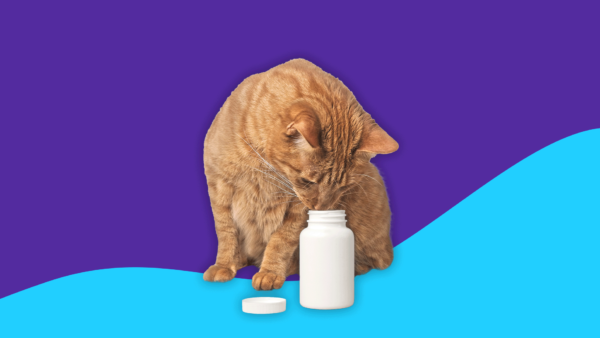Key takeaways
Meloxicam is used to treat symptoms of osteoarthritis in dogs.
The standard meloxicam dosage for dogs is 0.1 milligrams (mg) per kilogram (kg) of body weight (0.045 mg/lb).
The most common side effects of meloxicam in dogs are gastrointestinal issues such as vomiting, diarrhea, and appetite loss, but these can be signs of serious side effects.
Do not give meloxicam to dogs with a history of allergic reactions to meloxicam, gastrointestinal bleeding, kidney or liver problems, or bleeding disorders.
Meloxicam is approved by the U.S. Food and Drug Administration to treat dogs with osteoarthritis. Veterinarians may use it off-label as an injection to treat post-surgical pain or as an oral medicine for other pain conditions. As a nonsteroidal anti-inflammatory drug (NSAID), meloxicam reduces pain and inflammation. Although there are risks, meloxicam is FDA-approved as a veterinary medicine because it’s selective in its effects. In particular, it’s less likely to cause bleeding problems. However, pet owners should be aware of the signs and symptoms of potential side effects of meloxicam.
RELATED: Save up to 80% on meloxicam
What is meloxicam used for in dogs?
Meloxicam is FDA-approved to treat pain and inflammation in dogs with osteoarthritis. Veterinarians may use it off-label for other pain conditions, particularly as pain control after a surgical procedure.
Osteoarthritis pain and swelling
Osteoarthritis is the most common cause of chronic pain in dogs. While about 20% of dogs older than 1 year have some degree of osteoarthritis, about 2.5% of dogs are diagnosed with osteoarthritis by veterinarians. Since dogs cannot talk about their pain or stiffness, pet owners can recognize osteoarthritis or joint pain from the pet’s behaviors, including:
- Limping, lameness, or favoring one side when walking
- Reluctance to move
- Frequent changes of position when relaxing or lying down
- Difficulty getting up
- Weight shifting when standing
- Difficulty climbing stairs or getting into a car
- Resistance to being handled or picked up
- Restlessness
- Mood changes
Treatment consists of dietary changes, weight loss (if necessary), and controlled exercise. NSAIDs like meloxicam are the first-line treatment for pain and stiffness. A veterinarian may add other drugs such as tramadol, gabapentin, amantadine, or tricyclic antidepressants. Meloxicam for dogs is available under the brand names Metacam, Meloxidyl, LoxiCom EloxiOral, Melonex, and Ostilox. An oral spray is also available under the brand name OroCAM.
Is meloxicam safe for dogs?
Meloxicam is safe for dogs when prescribed by a veterinarian and given as directed. However, it is not 100% safe. Some animals should not be given meloxicam, while others may need special consideration.
Meloxicam should not be used in dogs who:
- Are allergic to meloxicam or other NSAID
- Are currently taking another NSAID or corticosteroid
- Have gastrointestinal bleeding
- Have gastrointestinal ulcers
- Have bleeding disorders
- Have kidney disease
- Have liver disease
- Are dehydrated
The safety of Meloxicam has not been fully evaluated in dogs who:
- Are breeding dogs
- Are pregnant or lactating
- Are younger than 6 months of age
Because meloxicam can cause problems with the liver and kidneys, your veterinarian should not prescribe meloxicam until they’ve examined the dog and taken appropriate blood tests. Your dog’s veterinarian should regularly monitor kidney and liver function using blood tests for continuous therapy. This is how the FDA warning is worded in the drug information sheet.
Side effects of meloxicam in dogs
If you suspect your dog is experiencing a meloxicam side effect, immediately stop giving the dog meloxicam and contact a veterinarian.
In clinical trials, the most common side effects of meloxicam in dogs were:
- Vomiting
- Diarrhea or soft stools
- Loss of appetite
- Blood in the stools
- Black and tarry stools
- Lethargy (decrease in activity levels and interest)
All of these common side effects may be a sign of more serious side effects such as gastrointestinal bleeding, stomach ulcers, liver dysfunction, or kidney impairment.
Other signs of serious side effects include changes in drinking, urination, yellowing of the eyes or gums (jaundice), skin changes, increased itchiness, behavior changes, and any behavior that indicates abdominal pain or distress.
Interactions of meloxicam with other pet meds
Meloxicam and other NSAIDs are not always safe to give to dogs who are on other medications.
The most important drugs to avoid are other NSAIDs. Giving a dog more than one NSAID at a time greatly increases the risk of severe side effects such as bleeding, kidney dysfunction, and liver dysfunction.
Corticosteroids like prednisone or dexamethasone shouldn’t be combined with meloxicam.
The combination greatly increases the risk of gastrointestinal bleeding.
When it’s time to start a corticosteroid or another NSAID, veterinarians will stop meloxicam for a few days before starting the new drug.
Some drugs increase the risk of kidney dysfunction or liver dysfunction when combined with an NSAID. These include diuretics and drugs that are toxic to the kidneys.
Combining an anticoagulant with an NSAID like meloxicam increases the risk of bleeding.
Meloxicam dosage for dogs
The standard meloxicam dosage involves an initial injection of 0.09 mg/lb (0.2 mg/kg) on the first day, followed by daily doses of meloxicam oral suspension of 0.045 mg/lb (1 mg/kg). Veterinarians may lower the dose over time to find the lowest possible effective dose.
Can dogs overdose on meloxicam?
Dogs can overdose on meloxicam, but no symptoms are listed in the veterinary literature other than long-term effects. If an overdose is suspected, call the veterinarian, a veterinary hospital, or an animal poison control center for advice.
Can I give my dog meloxicam every day?
Meloxicam is intended for daily dosing to treat the symptoms of osteoarthritis. There are risks, so pet owners should watch for side effects. If any suspected side effects are noticed, discontinue the medication immediately and contact the dog’s veterinarian.
How to give your dog meloxicam
Veterinarians should prescribe meloxicam formulated for dogs rather than human meloxicam tablets. Meloxicam for dogs comes as a liquid and is administered using a dropper bottle or oral syringe.
General use
- Follow all the dosing instructions from the veterinarian.
- Give only the dose prescribed. Do not give the dog extra medicine or more frequently than instructed.
- Shake the bottle well before measuring out a dose.
- Only use the dropper bottle or oral syringe supplied with the medicine to measure and administer a dose.
For dogs under 10 pounds
- Mix meloxicam drops with food for dogs weighing less than 10 pounds.
- Use the dropper bottle to measure a dose for dogs weighing less than two pounds (if prescribed 0.5 mg/mL meloxicam) or less than five pounds (if prescribed 1.5 mg/mL meloxicam). Dogs weighing more than this can be dosed either with the dropper bottle or the oral syringe.
- Dropper bottle dose: the correct dropper bottle dose will depend on the dosage strength:
- 0.5 mg/mL: two drops per pound of body weight
- 1.5 mg/mL: one drop per pound of body weight
- Oral syringe dose: the dosages are measured in pounds on the oral syringe, starting at two pounds (if prescribed 0.5 mg/mL meloxicam) or five pounds (if prescribed 1.5 mg/mL meloxicam). When measuring a dose, round the dog’s weight down to the nearest pound.
For dogs over 10 pounds
- For dogs over 10 pounds, doses can be mixed with food or given by mouth.
- Use the measuring syringe or dropper bottle that comes with the medicine. Using the oral syringe for dogs weighing more than 10 pounds may be easier than counting out drops with a dropper bottle.
- The correct dropper bottle dose will depend on the dosage strength of the medicine:
- 0.5 mg/mL: two drops per pound of body weight
- 1.5 mg/mL: one drop per pound of body weight
- The oral syringe measures doses in pounds of body weight, starting at two pounds (if prescribed 0.5 mg/mL meloxicam) or five pounds (if prescribed 1.5 mg/mL meloxicam).
- When measuring a dose, round the dog’s weight to the nearest one-pound increment. For instance, a dog weighing 21.5 pounds should be given a 21-pound dose.
Storage
- Store this medicine at room temperature
- Because it is sweetened, keep meloxicam out of the reach of children and pets.
If a veterinarian prescribes OroCAM, an oral transmucosal formulation of meloxicam, doses are given by spraying the solution on the inside of the dog’s cheeks. This medicine will come with a client information sheet with full instructions on how to give a dose. The veterinarian will specify how many sprays to provide each day.
Meloxicam alternatives for dogs
For chronic pain due to osteoarthritis, alternative medical treatments other than meloxicam include:
- Other NSAIDs appropriate for animals such as firocoxib, deracoxib, robenacoxib, vedaprofen, carprofen, or mavacoxib
- Both injected and oral corticosteroids, such as prednisone
- Opioids
- Gabapentin
- Amantadine
Natural or complementary therapies for chronic pain due to osteoarthritis include:
- Dietary changes
- Low-intensity exercise
- Glucosamine-chondroitin supplements
- Omega-3 fatty acids such as fish oil supplements
- Acupuncture
- Physical therapy
- Laser therapy
- Nerve stimulation
- Cannabidiol (CBD)
Summary
Meloxicam is FDA-approved to treat joint pain, stiffness, and swelling due to osteoarthritis in dogs. Like all NSAIDs, there are risks involved in the use of meloxicam. Veterinarians must do a complete physical examination and blood tests before prescribing this medicine. If used continuously, the dog will require regular blood tests to ensure the drug is not causing problems. Owners should watch for side effects. If meloxicam side effects are noticed, discontinue the medicine and call the veterinarian.
Sources
- Analgesics used in animals, Merck Veterinary Manual
- Chronic pain in animals, Merck Veterinary Manual
- Controlling pain and inflammation in your dog with nonsteroidal anti-inflammatory drugs, U.S. Food and Drug Administration (FDA)
- How to treat arthritis in dogs, SingleCare
- Meloxicam, Plumb’s Veterinary Medication Guides
- Meloxicam (Metacam), Veterinary Partner
- Metacam (meloxicam oral suspension), Boehringer Ingelheim
- Metacam meloxicam suspension prescribing information, NIH National Library of Medicine
- Meloxicam veterinary, American Academy of Veterinary Pharmacology and Therapeutics (AAVPT)
- Mobility matters, American Animal Hospital Association
- OroCAM transmucosal oral spray client information sheet, U.S. Food and Drug Administration (FDA)
- Recognizing pain and distress in animals, Boston University Office of Research











